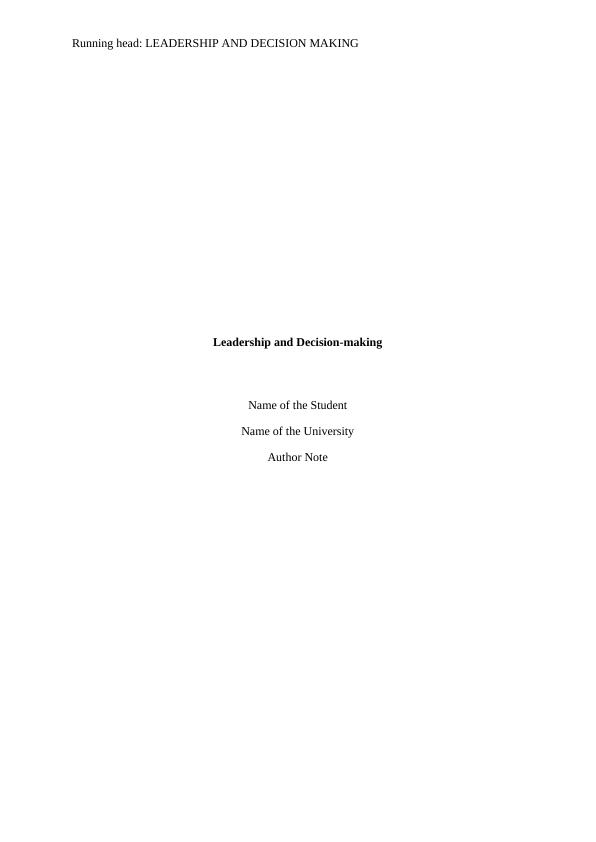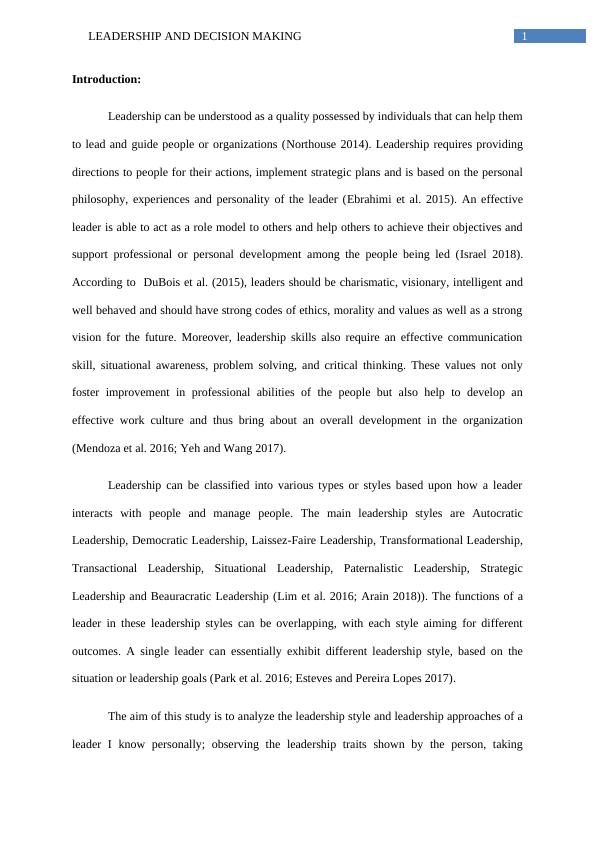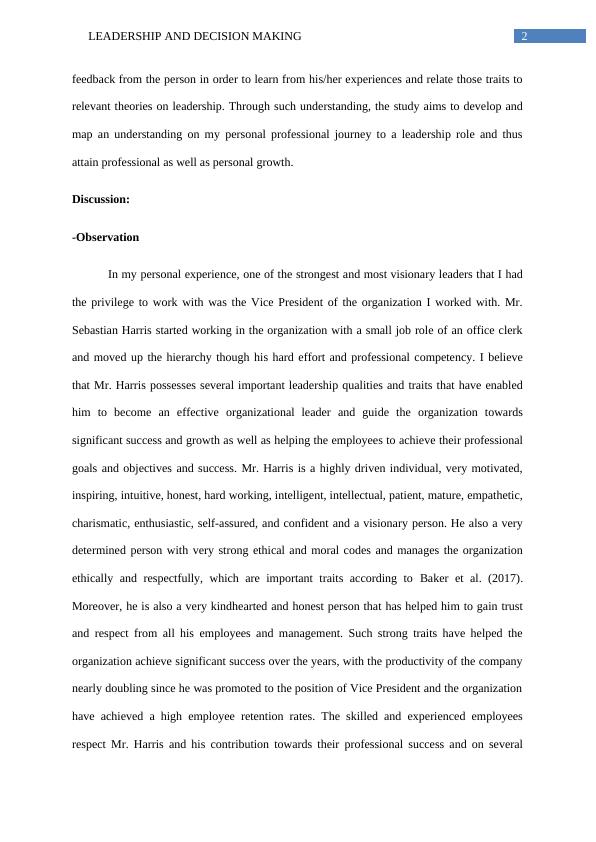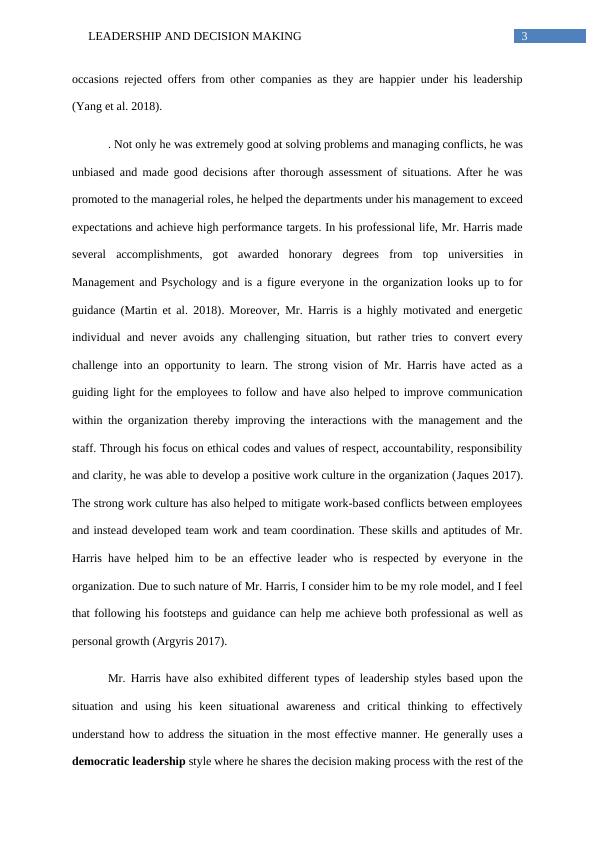Leadership and Decision-making
Added on 2023-04-20
14 Pages4128 Words241 Views
Running head: LEADERSHIP AND DECISION MAKING
Leadership and Decision-making
Name of the Student
Name of the University
Author Note
Leadership and Decision-making
Name of the Student
Name of the University
Author Note

1LEADERSHIP AND DECISION MAKING
Introduction:
Leadership can be understood as a quality possessed by individuals that can help them
to lead and guide people or organizations (Northouse 2014). Leadership requires providing
directions to people for their actions, implement strategic plans and is based on the personal
philosophy, experiences and personality of the leader (Ebrahimi et al. 2015). An effective
leader is able to act as a role model to others and help others to achieve their objectives and
support professional or personal development among the people being led (Israel 2018).
According to DuBois et al. (2015), leaders should be charismatic, visionary, intelligent and
well behaved and should have strong codes of ethics, morality and values as well as a strong
vision for the future. Moreover, leadership skills also require an effective communication
skill, situational awareness, problem solving, and critical thinking. These values not only
foster improvement in professional abilities of the people but also help to develop an
effective work culture and thus bring about an overall development in the organization
(Mendoza et al. 2016; Yeh and Wang 2017).
Leadership can be classified into various types or styles based upon how a leader
interacts with people and manage people. The main leadership styles are Autocratic
Leadership, Democratic Leadership, Laissez-Faire Leadership, Transformational Leadership,
Transactional Leadership, Situational Leadership, Paternalistic Leadership, Strategic
Leadership and Beauracratic Leadership (Lim et al. 2016; Arain 2018)). The functions of a
leader in these leadership styles can be overlapping, with each style aiming for different
outcomes. A single leader can essentially exhibit different leadership style, based on the
situation or leadership goals (Park et al. 2016; Esteves and Pereira Lopes 2017).
The aim of this study is to analyze the leadership style and leadership approaches of a
leader I know personally; observing the leadership traits shown by the person, taking
Introduction:
Leadership can be understood as a quality possessed by individuals that can help them
to lead and guide people or organizations (Northouse 2014). Leadership requires providing
directions to people for their actions, implement strategic plans and is based on the personal
philosophy, experiences and personality of the leader (Ebrahimi et al. 2015). An effective
leader is able to act as a role model to others and help others to achieve their objectives and
support professional or personal development among the people being led (Israel 2018).
According to DuBois et al. (2015), leaders should be charismatic, visionary, intelligent and
well behaved and should have strong codes of ethics, morality and values as well as a strong
vision for the future. Moreover, leadership skills also require an effective communication
skill, situational awareness, problem solving, and critical thinking. These values not only
foster improvement in professional abilities of the people but also help to develop an
effective work culture and thus bring about an overall development in the organization
(Mendoza et al. 2016; Yeh and Wang 2017).
Leadership can be classified into various types or styles based upon how a leader
interacts with people and manage people. The main leadership styles are Autocratic
Leadership, Democratic Leadership, Laissez-Faire Leadership, Transformational Leadership,
Transactional Leadership, Situational Leadership, Paternalistic Leadership, Strategic
Leadership and Beauracratic Leadership (Lim et al. 2016; Arain 2018)). The functions of a
leader in these leadership styles can be overlapping, with each style aiming for different
outcomes. A single leader can essentially exhibit different leadership style, based on the
situation or leadership goals (Park et al. 2016; Esteves and Pereira Lopes 2017).
The aim of this study is to analyze the leadership style and leadership approaches of a
leader I know personally; observing the leadership traits shown by the person, taking

2LEADERSHIP AND DECISION MAKING
feedback from the person in order to learn from his/her experiences and relate those traits to
relevant theories on leadership. Through such understanding, the study aims to develop and
map an understanding on my personal professional journey to a leadership role and thus
attain professional as well as personal growth.
Discussion:
-Observation
In my personal experience, one of the strongest and most visionary leaders that I had
the privilege to work with was the Vice President of the organization I worked with. Mr.
Sebastian Harris started working in the organization with a small job role of an office clerk
and moved up the hierarchy though his hard effort and professional competency. I believe
that Mr. Harris possesses several important leadership qualities and traits that have enabled
him to become an effective organizational leader and guide the organization towards
significant success and growth as well as helping the employees to achieve their professional
goals and objectives and success. Mr. Harris is a highly driven individual, very motivated,
inspiring, intuitive, honest, hard working, intelligent, intellectual, patient, mature, empathetic,
charismatic, enthusiastic, self-assured, and confident and a visionary person. He also a very
determined person with very strong ethical and moral codes and manages the organization
ethically and respectfully, which are important traits according to Baker et al. (2017).
Moreover, he is also a very kindhearted and honest person that has helped him to gain trust
and respect from all his employees and management. Such strong traits have helped the
organization achieve significant success over the years, with the productivity of the company
nearly doubling since he was promoted to the position of Vice President and the organization
have achieved a high employee retention rates. The skilled and experienced employees
respect Mr. Harris and his contribution towards their professional success and on several
feedback from the person in order to learn from his/her experiences and relate those traits to
relevant theories on leadership. Through such understanding, the study aims to develop and
map an understanding on my personal professional journey to a leadership role and thus
attain professional as well as personal growth.
Discussion:
-Observation
In my personal experience, one of the strongest and most visionary leaders that I had
the privilege to work with was the Vice President of the organization I worked with. Mr.
Sebastian Harris started working in the organization with a small job role of an office clerk
and moved up the hierarchy though his hard effort and professional competency. I believe
that Mr. Harris possesses several important leadership qualities and traits that have enabled
him to become an effective organizational leader and guide the organization towards
significant success and growth as well as helping the employees to achieve their professional
goals and objectives and success. Mr. Harris is a highly driven individual, very motivated,
inspiring, intuitive, honest, hard working, intelligent, intellectual, patient, mature, empathetic,
charismatic, enthusiastic, self-assured, and confident and a visionary person. He also a very
determined person with very strong ethical and moral codes and manages the organization
ethically and respectfully, which are important traits according to Baker et al. (2017).
Moreover, he is also a very kindhearted and honest person that has helped him to gain trust
and respect from all his employees and management. Such strong traits have helped the
organization achieve significant success over the years, with the productivity of the company
nearly doubling since he was promoted to the position of Vice President and the organization
have achieved a high employee retention rates. The skilled and experienced employees
respect Mr. Harris and his contribution towards their professional success and on several

3LEADERSHIP AND DECISION MAKING
occasions rejected offers from other companies as they are happier under his leadership
(Yang et al. 2018).
. Not only he was extremely good at solving problems and managing conflicts, he was
unbiased and made good decisions after thorough assessment of situations. After he was
promoted to the managerial roles, he helped the departments under his management to exceed
expectations and achieve high performance targets. In his professional life, Mr. Harris made
several accomplishments, got awarded honorary degrees from top universities in
Management and Psychology and is a figure everyone in the organization looks up to for
guidance (Martin et al. 2018). Moreover, Mr. Harris is a highly motivated and energetic
individual and never avoids any challenging situation, but rather tries to convert every
challenge into an opportunity to learn. The strong vision of Mr. Harris have acted as a
guiding light for the employees to follow and have also helped to improve communication
within the organization thereby improving the interactions with the management and the
staff. Through his focus on ethical codes and values of respect, accountability, responsibility
and clarity, he was able to develop a positive work culture in the organization (Jaques 2017).
The strong work culture has also helped to mitigate work-based conflicts between employees
and instead developed team work and team coordination. These skills and aptitudes of Mr.
Harris have helped him to be an effective leader who is respected by everyone in the
organization. Due to such nature of Mr. Harris, I consider him to be my role model, and I feel
that following his footsteps and guidance can help me achieve both professional as well as
personal growth (Argyris 2017).
Mr. Harris have also exhibited different types of leadership styles based upon the
situation and using his keen situational awareness and critical thinking to effectively
understand how to address the situation in the most effective manner. He generally uses a
democratic leadership style where he shares the decision making process with the rest of the
occasions rejected offers from other companies as they are happier under his leadership
(Yang et al. 2018).
. Not only he was extremely good at solving problems and managing conflicts, he was
unbiased and made good decisions after thorough assessment of situations. After he was
promoted to the managerial roles, he helped the departments under his management to exceed
expectations and achieve high performance targets. In his professional life, Mr. Harris made
several accomplishments, got awarded honorary degrees from top universities in
Management and Psychology and is a figure everyone in the organization looks up to for
guidance (Martin et al. 2018). Moreover, Mr. Harris is a highly motivated and energetic
individual and never avoids any challenging situation, but rather tries to convert every
challenge into an opportunity to learn. The strong vision of Mr. Harris have acted as a
guiding light for the employees to follow and have also helped to improve communication
within the organization thereby improving the interactions with the management and the
staff. Through his focus on ethical codes and values of respect, accountability, responsibility
and clarity, he was able to develop a positive work culture in the organization (Jaques 2017).
The strong work culture has also helped to mitigate work-based conflicts between employees
and instead developed team work and team coordination. These skills and aptitudes of Mr.
Harris have helped him to be an effective leader who is respected by everyone in the
organization. Due to such nature of Mr. Harris, I consider him to be my role model, and I feel
that following his footsteps and guidance can help me achieve both professional as well as
personal growth (Argyris 2017).
Mr. Harris have also exhibited different types of leadership styles based upon the
situation and using his keen situational awareness and critical thinking to effectively
understand how to address the situation in the most effective manner. He generally uses a
democratic leadership style where he shares the decision making process with the rest of the

End of preview
Want to access all the pages? Upload your documents or become a member.
Related Documents
Leadership: Self Reflectionlg...
|8
|2590
|279
The HRM Implications of Mergerlg...
|12
|3617
|370
Leadership Styles and Traitslg...
|9
|2168
|270
Leadership Management Profilelg...
|10
|1775
|230
Effective Leadership and Management - Doclg...
|18
|4922
|124
People, Culture and Contemporary Leadership: Theories, Styles and Personal Experiencelg...
|10
|2404
|96
